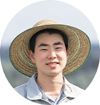Although it is still cold in the bee farm in March, the days are gradually getting longer, and I can already feel a hint of spring in the air. The honeybees that stood the cold in the beehive during the winter are briskly flying out of the beehives to return later with a lot of yellow pollen balls on their limbs.
This is a very important period for the beekeepers. That's because we must make preparations for the coming spring so that the bees can work comfortably. The queen bees start to lay eggs when the plum blossoms start to bloom, after having been idle in winter. They lay many more eggs as various flowers start to bloom.
We open the cover of the beehives and inspect each of the honeycomb plates by lifting it to examine the approximate number of bees and whether the queen bee is alive. We feel relieved to know that the bees have passed the winter safely only after making sure that the queen bees have started to lay eggs right on schedule for this year.
A swarm of about 10,000 bees that started "wintering" in December of last year is reduced to several thousands after passing the winter. These are only worker bees that emerged last October or November. Bees that passed the cold winter fly to the flowers of Ume (Plum) and Tsubaki (Camellia) and flowering plants of Ooinunofugeri (Veronica persica) and Tanpopo (Dandelion) by summoning up all their strength to collect pollen and nectar for nursing the next generation of bees.
In the beehive, worker bees secrete royal jelly they created in their bodies using pollen for material, and feed it to the queen bee, encouraging it to "be plentiful and increase the bee population." The queen bee receives the royal jelly secreted by worker bees from mouth to mouth. She uses the royal jelly as the source of energy for laying her eggs. As worker bees born after spring's arrival emerge, the number of bees increases and it becomes increasingly noisier inside the beehive. |
 |
The task for the beekeeper just before the spring is to help increase the number of bees as soon as possible. As the egg-laying site spreads, it becomes necessary to add empty plates for honeycombs. Also, bees are fed to stimulate the activity of the honeybees and to encourage the queen bee to lay more eggs. When we collect honey for the first time in this year before milk vetch flowers bloom, what is fed is removed as "sweep out honey" from the bee hive along with all of the remaining honey from the previous year.
As the proverb goes "The heat or cold lasts only until the equinox," we do not have to worry about the cold weather any more after the day of the Vernal Equinox. We normally remove the "winterization" materials that covered the beehives about this time. Soon, yellow rape blossoms will bloom and buds of cherry will start to swell.
Beekeepers count the number of bees based on the number of honeycomb plates. For example, we may have a one-plate swarm or a two-plate swarm. When a beehive becomes full of bees, their number increases to tens of thousands of bees that may comprise a nine-plate swarm. By the time when milk vetch flowers bloom in April, we stack the nine-plate swarm beehives in two tiers and, together with the bees, await the blooming of the milk vetch flowers.
|




